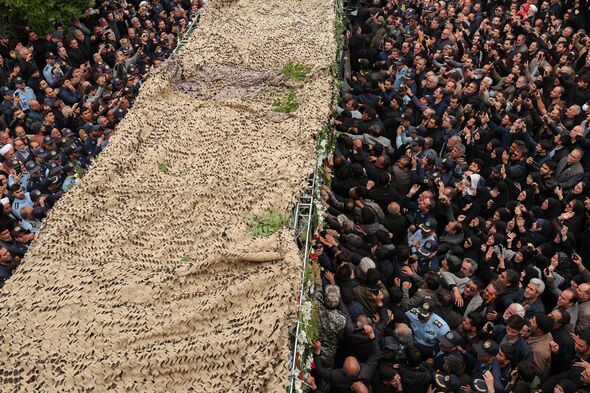Tens of thousands gathered to pay their respects today as funeral rites for the Iranian president Ebrahim Raisi, who died in a helicopter crash at the weekend, began across the country.
The main initial ceremony was taking place in Tabriz in the country’s north-west, the region where the crash happened on Sunday.
But not everyone in the country was respectful to the late cleric, with many Iranians also celebrating his death on social media.
Mr Raisi’s body is expected to be buried in his birthplace, Mashhad, on Thursday. But today the country went into a period of national mourning after the sudden loss of its hardline leader and his Foreign Minister Hossein Amir-Abdollahian.
Both died when their US-made Bell 212 helicopter came down in atrocious weather in the country’s mountainous northwest region as the pair were flying back to the country’s capital Tehran on Sunday night.
Tens of thousands of people took to the streets in Tabriz to mourn President Raisi yesterday, though it is known that far from everyone supported his hardline ways.
And the period of mourning will be a test for Iran’s conservative leaders who want to send out a clear and convincing signal of continuity.
Among the notable officials attending the funeral ceremony held in Tabriz was Ahmad Vahidi, the interior minister of Iran.
In a speech broadcast live by Iranian state TV, he said that if this incident happened in any other country, it would have faced a very “bleak future”.
But, he claimed, with the “reliving” existence of the Supreme Leader Ayatollah Ali Khamenei, Iran would “move through this event smoothly”.
Elsewhere, Iran was holding several other funeral ceremonies for President Raisi and the other officials killed in the helicopter crash.
After the event in Tabriz, Raisi’s body will then be moved to the religious city of Qom, where another procession is set to be held.
His and the other bodies will then being taken to the capital city of Tehran, with a further funeral ceremony happening there on Wednesday, with Supreme Leader Ayatolah Ali Khamenei leading congregational prayers for Raisi and others.
Wednesday has also been announced as a public holiday in Iran.
Raisi’s body will next be transferred on Thursday morning to Birjand, the capital of South Khorasan province, where the president had recently been re-elected as representative to the leadership watchdog body Assembly of Experts.
Raisi’s final burial ceremony will then be held in the north-eastern city of Mashhad, in the shrine of the eighth Shia Imam Reza on Thursday evening.
While Raisi was loved by hardliners of the Islamic Republic of Iran, he was equally hated by many Iranians for his role in the mass execution of political prisoners in the 1980s.
He was also despised his enemies for his more than four-decade involvement in the security and judicial systems which suppress opponents of the Islamic regime.
In the 1980s, Raisi was appointed to be a member of a death committee that dealt with political prisoners. More than 5,000 political prisoners were executed by this committee. Relatives of those executed long held onto hope that Raisi would one day face justice.
